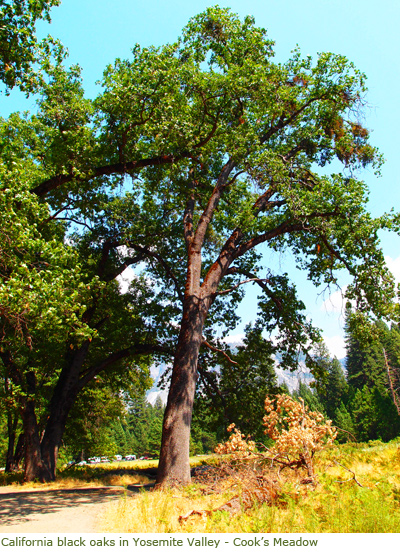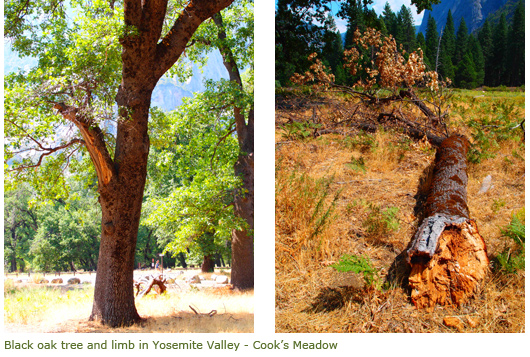 In Yosemite Valley, the California black oaks are one of the beautiful tree species we enjoy; unfortunately that beauty comes with inherent dangers. One of those dangers is sudden oak limb drop; a mysterious and potentially deadly phenomenon. It refers to large limbs breaking off of oak trees, often without warning. Commonly, the break site is quite blunt; rounded and flat, different than the sharp splintered ends that you might expect. Most commonly it happens during the summer months when the weather is warm and winds are calm. This phenomenon is also known to happen in other species of trees, so it is sometimes referred to by other names, such as "summer limb drop," or "sudden limb drop." But oak trees, like the black oak commonly found in Yosemite Valley, are especially prone to it, and have even caused deaths in the past to a few Yosemite Valley visitors.
In Yosemite Valley, the California black oaks are one of the beautiful tree species we enjoy; unfortunately that beauty comes with inherent dangers. One of those dangers is sudden oak limb drop; a mysterious and potentially deadly phenomenon. It refers to large limbs breaking off of oak trees, often without warning. Commonly, the break site is quite blunt; rounded and flat, different than the sharp splintered ends that you might expect. Most commonly it happens during the summer months when the weather is warm and winds are calm. This phenomenon is also known to happen in other species of trees, so it is sometimes referred to by other names, such as "summer limb drop," or "sudden limb drop." But oak trees, like the black oak commonly found in Yosemite Valley, are especially prone to it, and have even caused deaths in the past to a few Yosemite Valley visitors.
So why does it happen to those unsuspecting healthy trees and on calm, windless days? What makes it so mysterious is that no one really knows the exact science behind it. Nonetheless, there are many ideas and theories out there; here are just a few of them…
Trees draw up large amounts of water; the average oak can draw up 75-100 gallons of water per day, depending on the size of the tree and its root structure. The tree draws that water up through its root system and disperses it out to its branches where it slowly releases the moisture through pore-like stomata on its leaves. The process is known as evapotranspiration. You can witness this process by tying a plastic bag around a potted plant. The bag starts to fog up as moisture is released into the air. Some researchers believe that the limb drop occurs after the tree has not released enough of that moisture, and the weight of the water bearing down on the branch in the heat of the day causes it to suddenly break off. In some cases, after a large branch has suddenly broken off, water was reported pouring out of both sides of the break and is believed to be excess water that had not evapotranspirated.
Another theory is that water stress (such as a lack of water, or even excess water) causes the concentration of ethylene, a plant hormone, to increase. Ethylene is a gas that is produced by all plants, and it effects things like cell growth, cell development, and even cell aging. The theory is that the increased amount of ethylene dissolves the cementation of cell walls in the wood. This leaves less material to hold the cells together, causing the branch to suddenly break.
Others suggest that it might just be as simple as internal cracks in the branch caused by previous wounds, age, or stress that eventually spread outward, causing the branch to break off.

There are plenty of unknowns about summer limb drop, but one thing we do know is that there are ways to help protect yourself to ensure that you will not be injured by a falling limb. A good place to start is just being aware of what is above you; are you sitting in the shade of an oak tree? Or directly under a large limb? Who are you with? Remember to not leave grandma or the baby unattended, people who might not be able to remove themselves from that area quickly. Also think about the weather, is it a hot day with not much of a breeze?
Sudden limb drop is one of those unsolved mysteries! As mentioned previously there are many theories out there and I've shared just a few of them with you. So now using what you know, you be the judge!
